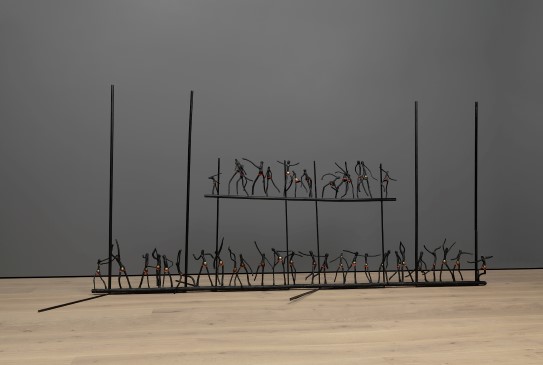War Dance
Annelise Josefsen
Transcription
Narrator
The artwork War Dance stands out from the rest of this room, which is mostly home to busts of rulers of the ancient world. The artist responsible for “War Dance”, Annelise Josefsen, describes the setting as follows:
Annelise Josefsen
Perhaps it’s a bit of a disrespectful thing to say, but these busts, which are very severe-looking, in a way resemble bigwigs engaged in political decision-making, while in the background we see ordinary people dancing around and laughing.
Narrator
The artist Annelise Josefsen was born after the end of the Second World War. She grew up in the far north of Norway, a region where everything had to be rebuilt after the war.
Annelise Josefsen
When people returned home, they found that everything they had owned was gone. And so to start with, they just used anything they could find for rebuilding.
Narrator
The war and its consequences are themes that she has taken into her work. Her sculpture “War Dance” is made of metal and plastic, plus acrylic and textiles, but is inspired by twigs from dwarf birch trees that she found on the Finnmark Plateau.
Annelise Josefsen
I’ve used twigs in my work for a long time – Y-shaped twigs like ones used for dowsing. And I’ve divided up the twigs and then assembled them to make a complete sculpture, and gradually it became a war dance.
It was when I dressed the figures in uniforms that the idea of war came up. Even when we’re children we can wave sticks and it makes us feel stronger. And when we all wear the same uniform, then we feel ourselves to be part of a herd, and that makes us feel strong.
Narrator
Currently there are somewhere between 25 and 30 wars taking place around the world. Many of them are civil wars. All wars have a brutal impact on civilians.
Annelise Josefsen
When it really matters, people don’t get to decide things for themselves. You get sent here and there, and get hyped up to go to war.
So, in a way, one is dancing to other people’s tunes, and we are continuing to dance – wars are happening all the time.
Narrator
Even so, this sculpture does have a sense of inner light that transcends culture and history:
Annelise Josefsen
This war dance is perhaps more of a peace dance, in the sense that in a way the war has ended. These people are not walking with their heads stooped towards the ground, in a way they are dancing.